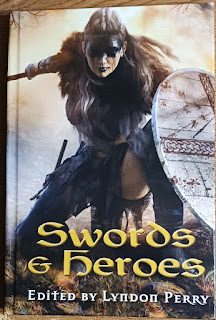Splatter Punks II Over the Edge: softcover, 416 pages. TOR 1995, edited by Paul M. Sammon.
This book came out in 1995, toward the end of the first generation of Splatterpunk. I wrote a few stories in that movement back in the day, Razor White (which appeared in Dark Voices 4 The Pan Book of Horror), Splatter of Black (which appeared in Dark Terrors), and Wall of Love (which appeared in Agony in Black). I haven’t done anything like those stories since, and I haven’t read a lot of this kind of material since then either. Even at age sixty-four, though, in 2023, I found myself wincing emotionally and viscerally at a few of these tales. There’s still power in these older stories. Below is the TOC, with a little description. My primary comments follow.
Personal Acknowledgments, by Paul M. Sammon
Introduction, Essay by Paul M. Sammon
Accident d'Amour, story by Wildy Petoud, Translated from French
Impermanent Mercies, story by Kathe Koja
One Flesh: A Cautionary Tale, story by Robert Devereaux
Rant, story by Nancy A Collins
Lacunae, story by Karl Edward Wagner
Heels, story by Lucy Taylor
Brian De Palma: The Movie Brute, essay by Martin Amis
I Walk Alone, story by Roberta Lannes
Scape-Goats, story by Clive Barker
Cannibal Cats Come Out Tonight, story by Nancy Holder
All Flesh is Clay, story by John J Ordover
Imprint, story by Nina Kiriki Hoffman
Twenty-two and Absolutely Free, story by John Piwarski
Hooked on Buzzer, story by Elizabeth Massie
Pig, story by Gorman Bechard
Rockin' the Midnight Hour, essay by Anya Martin
Embers, story by Brian Hodge
Headturner, story by Kevin Andrew Murphy and Thomas S. Roche
Nothing But Enemies, story by Debbie Goad
Boxer, story by Steve Rasnic Tem
Xenophobia, story by Poppy Z. Brite
Dripping Crackers, story by Michael Ryan Zimmerman
Intimates, story by Melanie Tem
For You, the Living, long story by Wayne Allen Sallee
Calling Dr Satan, interview with Anton Szandor Lavey by Jim Goad
Red Shift, story by Shira Daemon
Within You, Without You, story by Paul M. Sammon
Epiphany, story by Christa Faust
Note on the Splat II Soundtrack, essay by Paul M. Sammon
This is a big book with a lot of material. I didn’t read it quickly but typically read a story or two each day, depending on length. Some of these tales are long enough to be called Novellettes. None of them are weak tales. All are professional, although some resonated with me more than others for various personal reasons.
I bought the collection primarily for the works of certain authors whose careers I’ve followed. These would be Karl Edward Wagner, Clive Barker, Poppy Z. Brite (here), and Wayne Allen Sallee. I’ve actually met all four of these authors at various cons, though could only consider Sallee to be a friend. Wagner, of course, is gone now, a great tragedy.
I love the Kane stories by Karl Edward Wagner, most of which are set in a primitive Sword & Sorcery/Dark Gothic type of universe (ancient Earth). This is a rarity in that it’s set in the modern world. Not one of my favorite Kane stories but it still has that touch and I enjoyed it.
Clive Barker wrote some of the best horror stories in history in his Books of Blood. This one, “Scape-Goats,” fits right into that legacy. Very compelling and one of the strongest stories in the collection.
Poppy Z. Brite’s entry here is Xenophobia. Brite definitely had a finger on the pulse of a generation with the excellent novel, “Lost Souls.” This tale has many of those same kinds of touches.
Wayne Allen Sallee is in my top five favorite horror authors. He’s really created a unique and oftentimes grotesque body of work. I’d read this tale, “For You, The Living,” in another setting so it was no surprise for me. It still had the power to make me both viscerally and emotionally uncomfortable, and embodies (For me) a lot of what the Splatterpunk movement was about. Do yourself a favor if you like horror and give Sallee's work a read.
Like I said, I’m enjoyed all these tales. I’m only going to mention a couple more that hit me particularly hard. “Boxer,” by Steve Rasnic Tem was absolutely brutal. Nancy Holder’s “Cannibal Cats Come Out Tonight” was very well written.
My favorite story in the collection was the last one, by Christa Faust, “Epiphany.” Beautiful prose and a distinctly discomfiting subject matter for me. This one inspired some ideas for tales of my own.
As for the nonfiction, interesting material. I rather enjoyed the interview with Anton Lavey. I’ve not paid much attention to his philosophical thoughts previously but he had some interesting things to say, and not what one might typically expect.
All in all, I’m happy to add this anthology to my burgeoning collection.



